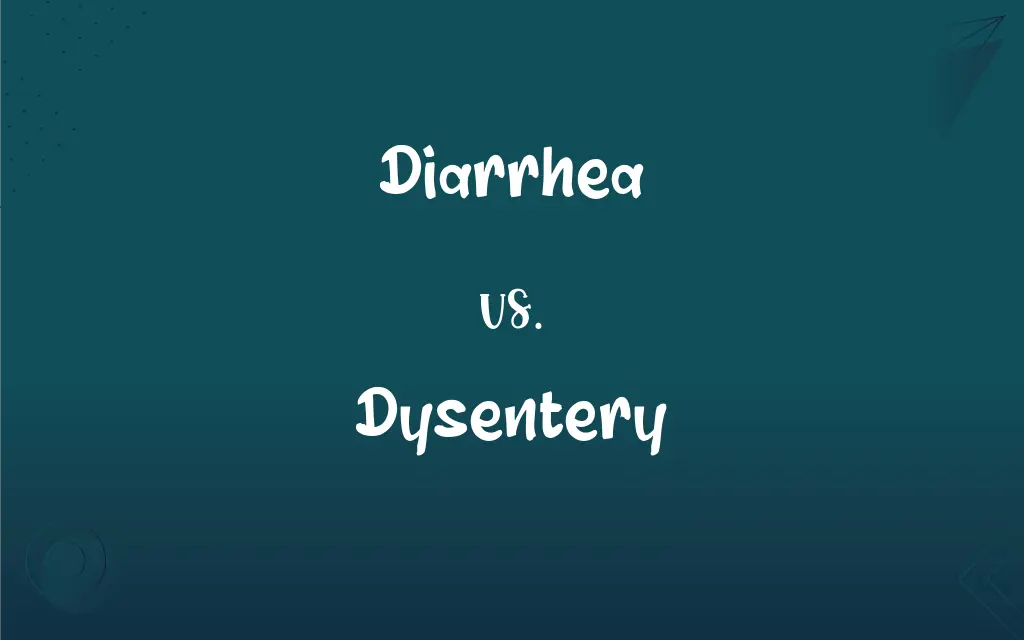Diarrhea vs. Dysentery: What's the Difference?
Edited by Aimie Carlson || By Harlon Moss || Updated on October 27, 2023
Diarrhea involves frequent, watery stools, while dysentery is diarrhea with blood and mucus due to inflammation.

Key Differences
Diarrhea and dysentery are both conditions related to the digestive system, manifesting primarily through abnormal bowel movements. Diarrhea is characterized by loose and watery stools that occur frequently. Dysentery, on the other hand, is a specific type of diarrhea where stools contain blood and mucus.
The primary distinction between diarrhea and dysentery lies in their causes and manifestations. While diarrhea can result from various factors like infections, dietary intolerances, or certain medications, dysentery usually arises from bacterial or parasitic infections that lead to inflammation of the intestines.
Symptoms accompanying diarrhea and dysentery also differ. While both can result in dehydration due to fluid loss, dysentery often comes with additional symptoms like abdominal pain, fever, and the presence of mucus or blood in stools. On the other hand, diarrhea, in its milder forms, might not present with such severe symptoms.
Preventive measures for both diarrhea and dysentery emphasize cleanliness and safe food and water consumption. However, while mild diarrhea may resolve on its own or with hydration solutions, dysentery often requires targeted medical treatment, such as antibiotics, due to its infectious nature.
In summary, while diarrhea focuses on the frequency and consistency of bowel movements, dysentery is concerned with the inflammatory and bloody nature of the diarrhea, usually pointing to a more severe underlying condition.
ADVERTISEMENT
Comparison Chart
Main Characteristic
Frequent, watery stools
Diarrhea with blood and mucus due to inflammation
Typical Causes
Infections, diet, medications
Bacterial or parasitic infections
Common Symptoms
Loose stools, dehydration
Abdominal pain, fever, blood/mucus in stools
Severity
Can range from mild to severe
Typically more severe due to inflammation
Treatment
Hydration, dietary changes
Often requires antibiotics or antiparasitic medications
ADVERTISEMENT
Diarrhea and Dysentery Definitions
Diarrhea
Diarrhea can be a symptom of infections, dietary issues, or certain medications.
Travelers often get diarrhea from consuming contaminated water.
Dysentery
Dysentery is a form of severe diarrhea with blood and mucus in the stool.
Dysentery can be life-threatening if not treated promptly.
Diarrhea
Diarrhea results in rapid loss of fluids from the body.
It's essential to stay hydrated when experiencing diarrhea.
Dysentery
Dysentery requires medical intervention for treatment.
Antibiotics are often prescribed to treat bacterial dysentery.
Diarrhea
Diarrhea is the condition of having frequent and loose or liquid stools.
After eating spoiled food, she experienced severe diarrhea.
Dysentery
Dysentery is often caused by bacterial or parasitic infections.
Shigella bacteria is a common cause of dysentery.
Diarrhea
Diarrhea is often a body's way to expel harmful substances.
Food poisoning often results in diarrhea as the body tries to eliminate toxins.
Dysentery
Dysentery can spread through contaminated food or water.
Travelers are advised to drink filtered water to avoid dysentery.
Diarrhea
Diarrhea can be acute (short-term) or chronic (long-term).
If diarrhea lasts more than a few days, it's essential to consult a doctor.
Dysentery
Dysentery results in inflammation of the intestines.
The inflammation caused by dysentery can lead to painful bowel movements.
Diarrhea
Excessive and frequent evacuation of watery feces.
Dysentery
Any of several inflammatory disorders of the intestines, especially the colon, characterized by abdominal pain, fever, and severe diarrhea often with blood and mucus in the stool, usually caused by infection with bacteria or parasitic protozoans.
Diarrhea
A gastrointestinal disorder characterized by frequent and very soft or watery bowel movements.
Dysentery
(pathology) A disease characterised by inflammation of the intestines, especially the colon (large intestine), accompanied by pus (white blood cells) in the feces, fever, pain in the abdomen, high-volume diarrhea, and possible blood in the feces.
Diarrhea
The watery or very soft excrement that comes from such bowel movements.
Dysentery
Diarrhea.
Diarrhea
A morbidly frequent and profuse discharge of loose or fluid evacuations from the intestines, without tenesmus; a purging or looseness of the bowels; a flux.
Dysentery
A disease attended with inflammation and ulceration of the colon and rectum, and characterized by griping pains, constant desire to evacuate the bowels, and the discharge of mucus and blood.
Diarrhea
Frequent and watery bowel movements; can be a symptom of infection or food poisoning or colitis or a gastrointestinal tumor
Dysentery
An infection of the intestines marked by severe diarrhea
FAQs
What causes dysentery?
Dysentery is often caused by bacterial or parasitic infections.
Can diarrhea be self-resolving?
Yes, mild cases of diarrhea often resolve on their own with hydration.
Is blood in stools a symptom of diarrhea?
Not typically for general diarrhea; blood indicates dysentery.
What characterizes diarrhea?
Diarrhea is characterized by frequent and watery stools.
How can diarrhea be prevented?
Consuming clean water, safe food, and maintaining hygiene can help prevent diarrhea.
Can dysentery lead to long-term issues?
If untreated, dysentery can cause long-term intestinal damage or other health issues.
What complications can arise from dysentery?
Untreated dysentery can lead to severe dehydration, rectal damage, and other complications.
When should one see a doctor for dysentery?
At the first sign, especially if there's blood in stools, fever, or severe dehydration symptoms.
Is dysentery contagious?
Yes, dysentery can spread, especially through contaminated food or water.
How is dysentery treated?
Dysentery often requires medical treatment, including antibiotics.
How long does dysentery last?
With treatment, symptoms of dysentery usually improve within 3-7 days.
Are there natural remedies for diarrhea?
While hydration is essential, some find relief with natural remedies like ginger or chamomile, but always consult a doctor.
Should one avoid dairy during diarrhea?
Many people are temporarily lactose intolerant during diarrhea, so avoiding dairy can help.
Is dysentery more severe than regular diarrhea?
Typically, yes, as dysentery involves intestinal inflammation and blood in stools.
Can medications cause diarrhea?
Yes, certain medications can have diarrhea as a side effect.
Is mucus in stools a sign of dysentery?
Yes, mucus and blood in stools can indicate dysentery.
Are children more susceptible to diarrhea?
Yes, children, especially in developing countries, are at higher risk of severe diarrhea.
How does one differentiate between diarrhea and dysentery?
Dysentery is differentiated by blood and mucus in stools and often more severe symptoms.
Can probiotics help with diarrhea?
Probiotics can help restore gut flora and may aid in some diarrhea cases.
Can dehydration result from diarrhea?
Yes, diarrhea can lead to rapid fluid loss and dehydration.
About Author
Written by
Harlon MossHarlon is a seasoned quality moderator and accomplished content writer for Difference Wiki. An alumnus of the prestigious University of California, he earned his degree in Computer Science. Leveraging his academic background, Harlon brings a meticulous and informed perspective to his work, ensuring content accuracy and excellence.
Edited by
Aimie CarlsonAimie Carlson, holding a master's degree in English literature, is a fervent English language enthusiast. She lends her writing talents to Difference Wiki, a prominent website that specializes in comparisons, offering readers insightful analyses that both captivate and inform.
































































